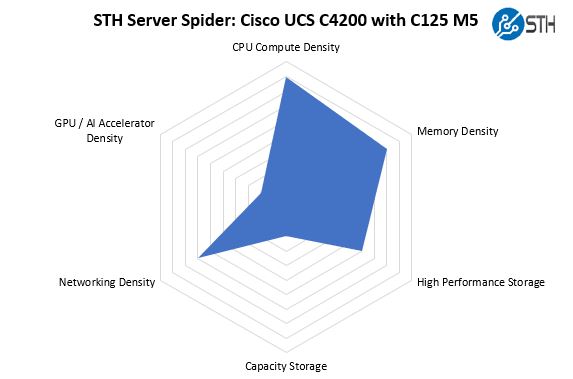STH Server Spider: Cisco UCS C4200
In the second half of 2018, we introduced the STH Server Spider as a quick reference to where a server system’s aptitude lies. Our goal is to start giving a quick visual depiction of the types of parameters that a server is targeted at.

As a 2.5″ chassis, one does not get 3.5″ capacity storage options and 2U4N designs are not known for great accelerator density. What one gets instead is excellent compute, memory, NIC, and 2.5″ storage density. This is designed to have excellent density and have 3.5″ capacity storage sit elsewhere on the network.
Final Words
Cisco made an excellent choice here on a number of fronts. Using AMD EPYC 7002 series CPUs will mean this chassis will scale from 256 cores/ 512 threads in this generation to 512 cores/ 1024 threads in Q3 2019. Had Cisco chosen to build around Intel, that would only be 224 cores and 448 threads in 2U using the Q2 2019 Xeon generation. A decision and faith in the new platform years ago means that by the end of Q3 2019, Cisco will have 2.28x as many cores per U as companies who went the Intel Xeon route. With the Cisco UCS C4200, compute density is the primary design objective and placing a bet years ago on AMD means that it is beating rivals still using Intel Xeon.
The mechanical design of the entire Cisco UCS C4200 package is excellent. We wish that the rails were ever so slightly smaller to accommodate more rack sizes, especially when zero U PDUs can potentially interfere. Otherwise, the Cisco UCS mechanical design team did an excellent job and one can clearly see a delta between the UCS C4200 and white box competitors. We have either reviewed or have in the lab waiting for review every white box competitor AMD EPYC 2U4N system. The UCS team is leading the pack.
Performance of the Cisco UCS C4200 was excellent. We saw top tier power consumption savings from the 2U4N design while maintaining similar performance to what we would see with 1U servers. Cisco manages that while also increasing density and lowering the number of components.
Overall, if you are looking for the top-end of compute density, the Cisco UCS C4200 ticks all of the important boxes with a clear path to future expansion.




I’m sure you’re right. Cisco has been doing this so long they’ve got to have a dedicated usability team.
I got one of these to test about 4 months ago loved it. Used cisco intersight for deployment. It was a little rough with the c125’s but updates were literally coming out weekly and it handled my M4 and M5 servers perfectly. I plan on replacing my whole UCS b series with C4200 and intersight once rome is released. Really happy to see this review, was the final nail in the coffin for the B series for me.
I knew Supermicro and Gigabyte had 2u4n but never knew Cisco did until I read this.